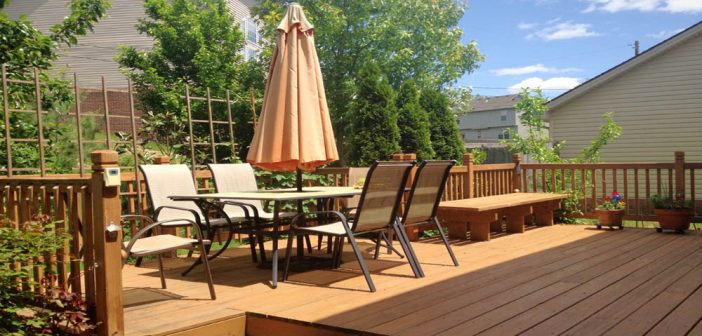A deck extends your home’s living space to the outdoors, allowing you and your family to enjoy the sunshine and fresh air. When weather permits, you can host outdoor parties, barbecues or just relax in a lounge chair. To take advantage of these benefits, though, you should perform a deck safety inspection on a regular basis. Doing so will allow you to identify and fix common hazards before they result in injury.
Rotted Wood
Whether your deck is made of redwood, cedar or any other hardwood material, you should inspect it for signs of rot. When a rot-causing fungus takes hold, it can quickly jeopardize your deck’s structural integrity. The wood planks will weaken and decay to the point where they can no longer support weight. If you step on a fully rotted plank, your foot may go straight through. You can protect your wooden deck from rot by applying a waterproof finish. And if a few planks have already begun to rot, replace them as soon as possible to prevent it from spreading.
Mildew
Mildew is a commonly overlooked safety hazard of decks. Like rot, it’s caused by fungi attaching itself to and feasting on the organic matter of wood. Although it typically won’t destroy your deck, it still presents a safety hazard that must be addressed. When mildew forms, it creates a slippery surface that increases the risk of fall-related injuries. You can clean mildew from your deck by pressure washing the affected areas or scrubbing it with water and liquid laundry detergent.
Protruding Nails
It’s not uncommon for nails to protrude out of wooden decks. As the wooden planks expand and contract, this force gradually pushes out the nails. Eventually, the nails may stick 1 inch or higher out of the deck. Protruding nails such as this pose a safety risk to anyone using your deck. Someone could stump their toe or trip and fall. Depending on the extend of the protrusion, it may also cause planks to detach themselves from your deck’s frame. Either hammer down or replace protruding nails to prevent this from happening.
Cupping
Cupping occurs when the wooden planks of a deck begin warp inward, creating the shape of a bowl or cup. This phenomenon is most common with decks that receive full sun exposure throughout the day. The sun causes the moisture within the top of the wooden planks to evaporate more quickly than the moisture within the bottom of the planks. Aside from being an eyesore, though, cupping also increases the risk of rot. When your deck’s planks begin to warp, water will collect in the center instead of draining away. Using high-quality, pressure-treated lumber can protect your deck from cupping.
Termites
Termites are the bane of all homeowners. These wood-boring pests cause billions of dollars worth of damage each year. If your deck is made of untreated wood, termites can damage or destroy it. Some characteristic signs of an infestation include the presence of wings, shelter tubes and hollow planks. If you believe your deck is infested with termites, replace the affected planks with new, pressure-treated wood planks.
Loose Guardrail
The International Residential Code (IRC) requires all residential decks higher than 30 inches from the ground to have a 36 inch or taller guardrail. But a guardrail is only useful if it’s stable and not loose. If a family member or guest attempts to grab the guardrail to catch their fail, he or she could be injured. Assuming your deck’s guardrail is loose because of loose nails, not rot, drive some carriage bolts into them.
Unstable Stairs
Unstable stairs is another safety hazard to look for when inspecting your deck. Like your deck’s main wooden planks, they too can rot or become loose. This hazard is easily avoided, however, by inspecting your stairs on a regular basis. If they are loose, hammer back down the affected nails and consider adding new nails for additional support.
Sunken Posts
When inspecting underneath the area underneath your deck, look to see if the posts have sunken into the ground. Sinking often foretells of bigger problems to come. As the posts sink deeper into the ground, the deck becomes unstable. Eventually, your deck may pull away from your home, causing serious structural damage to your property. This problem is usually the result of a loose foundation, so fixing it requires foundation repair.
Fire Hazards
Are there are fire hazards on your deck? There’s nothing wrong with using a fire pit, grill or meat smoker on your deck, but you should take precautions to protect against structural fire damage. Most experts recommend placing fire pits and other fire-burning devices such as these at least 10 feet away from you home. Furthermore, a protective pad should be placed underneath the device to protect your deck’s wooden planks. Even if the heat doesn’t cause the wooden planks to catch fire, it may char them, leaving an unsightly layer of black soot. A fire-resistant pad will protect your deck from fire damage.
Loose Fasteners
Whether it’s a nail, screw or supporting anchor, you should check your deck’s fasteners to ensure they aren’t loose. Over time, fasteners may work their way out from the area in which they were installed. If you discover any loose fasteners, use a hammer or screwdriver to secure them back in place. If the fastener is damaged, replace it with a new one of the same type.
Overhanging Tree Limbs
Tree limbs aren’t necessarily bad. In fact, they provide valuable coverage and protection from the sun. If the tree is dead, however, it poses a risk of injury. A strong gust of wind can send dead branches falling to your deck. So, cut down any dying, dead or otherwise weak branches hanging over your deck.
While performing a complete safety inspection of your deck takes time and energy, it’s well worth the investment. It will prolong the life of your deck, protect against serious damage and create a safer outdoor living space.









